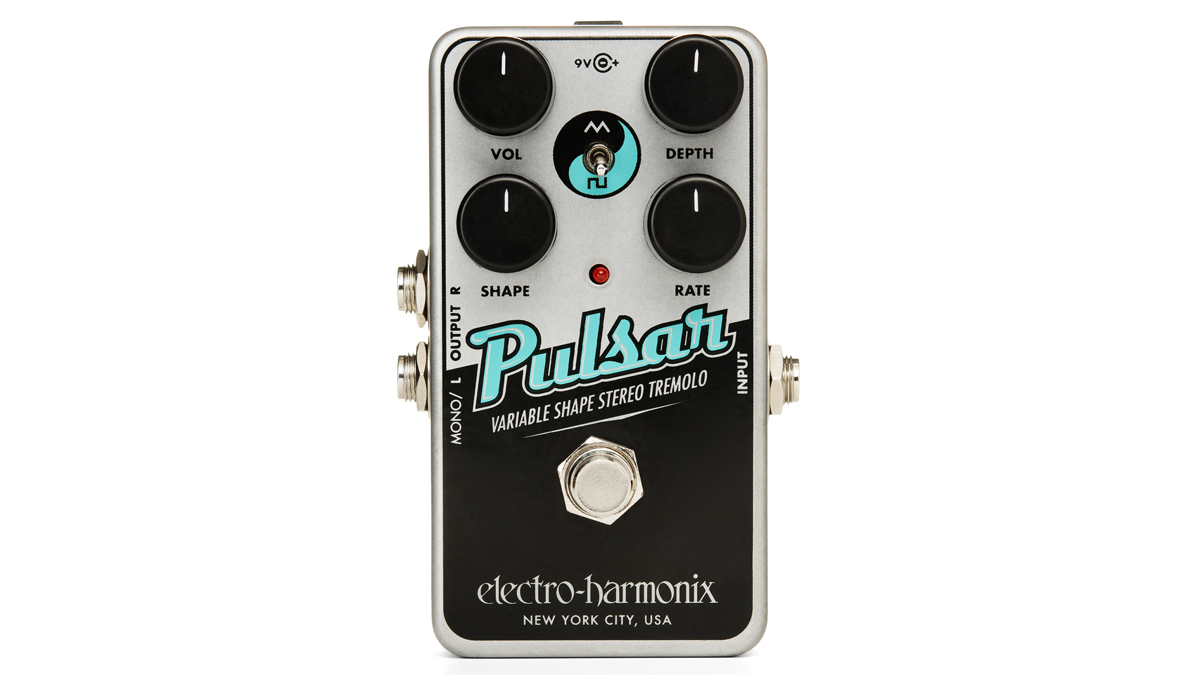GuitarPlayer Verdict
With no presets or tap tempo, the Pulsar may find use largely in the studio, but you could easily stumble across a couple of unique sounds that you must have for live performance
Pros
- +
Wide range of inspiring tremolo and pan effects in a small, affordable package
Cons
- -
Begs for a tap tempo option
You can trust Guitar Player.
Electro-Harmonix introduced the original Pulsar around 1979, and it was one of the first tremolo pedal effects. Original is the operative word here, because like most EHX devices, it offered a unique take on a classic sound.
From the beginning, the pedal provided many more sound-shaping possibilities than your classic amp tremolo. There was a switch to toggle between amp-like triangle and synth-style square-wave choppiness, as well as a knob to further shape the character of the unit’s pulsing, volume-sculpted rhythms.
Over the years, while retaining the same controls, the pedal went from a small housing to a larger one, then returned to a smaller, more robust package with a stereo option that adds panning to the equation.
The new Nano version is the smallest housing yet, yet it sacrifices no modifiers or stereo functionality. In fact, an additional control has been added. As there is often a perceived level drop when a tremolo effect is engaged, EHX has included a volume control to compensate for this.
The depth knob is just one area in which this pedal differs from your typical tremolo/panning effect. It has the usual function of adjusting the amount of tremolo, but push it past around one o’clock and the modulation becomes asymmetrical, warping the audio signal between positive and negative phases. To my ears, it then hovers somewhere between a Leslie and a harmonic tremolo.
The rate knob provides an enormous range of speed adjustment for the tremolo or pan effect. At it slowest, I found it unusable for tremolo, but when set to run very slow on the square wave setting, it made for an interesting panning effect, as the signal spent a long time in one amp before jumping to the other. At high speeds it enters into ring-modulation territory.
The shape knob gradually shifts from falling to rising sawtooth, and from narrow to wide pulse width. The rate/status LED pulses to show the speed of the effect when it's engaged. The Pulsar runs on an included nine-volt battery or an optional power supply.
All the latest guitar news, interviews, lessons, reviews, deals and more, direct to your inbox!
If you’re trying to match the sound of the classic amp tremolo in your Fender or Vox, the Nano Pulsar might not be for you, although I could definitely get a usable vintage-style sound from it.
Where this pedal came alive was when I stomped on my octave fuzz and ran it through a galloping square-wave rhythm for a terrific analog synth-style sound. There is no tap tempo, so, live, you will have to start the song and have the drummer match the tempo you set on the pedal. Using it to record with a drum loop, I was able to set the rhythm to sync for as long as my guitar chords sustained, which is all you really need.

Thanks to the interaction between the shape, depth, and rate controls, the Pulsar presents an abundance of cool sounds that can’t be achieved with standard amp tremolo.
With no presets and the aforementioned lack of tap tempo, the Pulsar may find use largely in the studio, but you could easily stumble across a couple of unique sounds that you must have for live performance. In fact, with the Nano Pulsar’s small size and low price, you could strap two of them on your board for less than the cost of some larger boutique pedals.
Specifications
CONTACT: ehx.com
PRICE: $99 street
CONTROLS: Volume, depth, rate, shape, waveform toggle
EXTRAS: Stereo operation
SIZE: 4.5” x 2.75” x 2.1”
BUILT: USA

